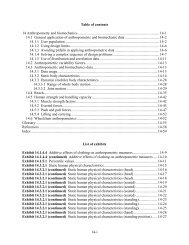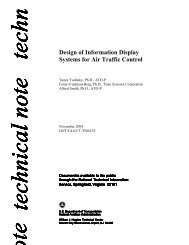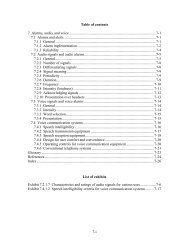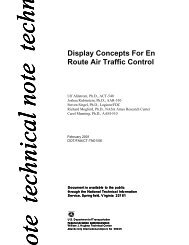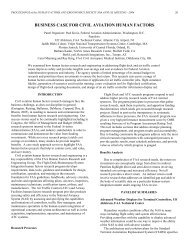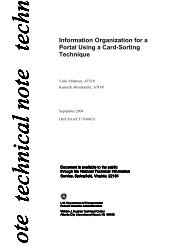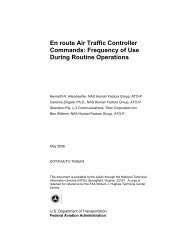Human Factors Criteria for the Design and Acquisition of ... - FAA
Human Factors Criteria for the Design and Acquisition of ... - FAA
Human Factors Criteria for the Design and Acquisition of ... - FAA
Create successful ePaper yourself
Turn your PDF publications into a flip-book with our unique Google optimized e-Paper software.
Keyboards June 2004Gerard, M. J., Armstrong, T. J., Martin, B. J., & Rempel, D. A. (2002). Effects <strong>of</strong>workplace on within-participant <strong>and</strong> between-participant keying <strong>for</strong>ce,electromyography, <strong>and</strong> fatigue. <strong>Human</strong> <strong>Factors</strong>, 44.Gerard, M. J., Armstrong, T. J., Rempel, D. A., & Woolley, C. (2002). Short term <strong>and</strong>long term effects <strong>of</strong> enhanced auditory feedback on typing <strong>for</strong>ce, EMG, <strong>and</strong>com<strong>for</strong>t while typing. Applied Ergonomics, 33 (2), 129-138.Gerard, M. J., Jones, S. K., Smith, L. A., Thomas, R. E., & Wang, T. (1994). Anergonomic evaluation <strong>of</strong> <strong>the</strong> Kinesis ergonomic computer keyboard. Ergonomics,37, 1661-1668.Gerr, F., Marcus, M., & Monteilh, C. (2004). Epidemiology <strong>of</strong> musculoskeletal disordersamong computer users: lesson learned from <strong>the</strong> role <strong>of</strong> posture <strong>and</strong> keyboard use.Journal <strong>of</strong> electromyography <strong>and</strong> kinesiology, 14, 25-31.Goldstein, M., Book, R., Alsio, G., & Tessa, S. (1999). Non-keyboard QWERTY touchtyping: a portable input interface <strong>for</strong> <strong>the</strong> mobile user. Proceedings <strong>of</strong> <strong>the</strong> SIGCHIConference on <strong>Human</strong> <strong>Factors</strong> in Computing Systems.Gopher, D., Hilsernath, H., & Raij, D., (1985). Steps in <strong>the</strong> development <strong>of</strong> a new dataentry device based upon two-h<strong>and</strong> chord keyboard. Proceedings <strong>of</strong> <strong>Human</strong><strong>Factors</strong> <strong>and</strong> Ergonomics Society. 29, 132.Gr<strong>and</strong>jean, E. (1969). Fitting <strong>the</strong> task to <strong>the</strong> man. Taylor & Francis, London.Gr<strong>and</strong>jean, E. (1988). The design <strong>of</strong> workstations. In Fitting <strong>the</strong> task to <strong>the</strong> man. 78-81.Taylor & Francis, London.Gr<strong>and</strong>jean, E., Hunting, W., & Piderman, M. (1983). VDT workstation design: Preferredsettings <strong>and</strong> <strong>the</strong>ir effects. <strong>Human</strong> <strong>Factors</strong>, 25, 161-175.Greenstein, J. S. & Muto, W. H. (1988). Keyboards. In A. Sherr (Ed.), Input Devices.Boston: Academic Press.Hagglund, K. L., & Jacobs, K. (1996). Comparisons <strong>of</strong> wrist postures in VDT operatorsusing wrist rests <strong>and</strong> <strong>for</strong>earm supports, Work, 7 (3), 145-162.Hansen, M. (1983). Keyboard design variables evaluated during dual-task modeselection. Proceedings <strong>of</strong> <strong>the</strong> <strong>Human</strong> <strong>Factors</strong> <strong>and</strong> Ergonomics Society, 27, 924.Hashimoto, M. & Togasi, M. (1995). CHI '95 Mosaic <strong>of</strong> Creativity. CHI Companion 95,Denver, Colorado.Hedge, A., McCrobie, D., L<strong>and</strong>, B, Morimoto, S., & Rodriguez, S. (1995). Healthykeyboarding: Effects <strong>of</strong> wrist rests, keyboard trays, <strong>and</strong> a preset tilt-down systemon wrist posture, seated posture, <strong>and</strong> musculoskeletal discom<strong>for</strong>t. Proceedings <strong>of</strong><strong>the</strong> <strong>Human</strong> <strong>Factors</strong> <strong>and</strong> Ergonomics Society, 39, 630.Hedge, A., Morimoto, S., McCrobie, D. (1999). Effects <strong>of</strong> tray geometry on upper bodyposture <strong>and</strong> com<strong>for</strong>t. Ergonomics, 42 (10), 1333-1349Hedge, A., & Powers, I. R. (1995). Wrist postures while keyboarding: Effects <strong>of</strong> anegative slope keyboard system <strong>and</strong> full motion <strong>for</strong>earm supports. Ergonomics,38, 508-517.9-49



